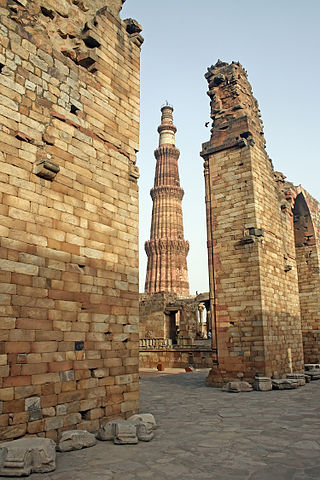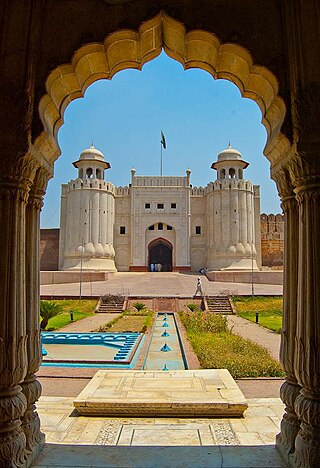| Mughal Minar (stupa) | |
|---|---|
 | |
| Religion | |
| Affiliation | Tibetan Buddhism |
| Location | |
| Location | Gilgit |
Mughal Minar is an archaeological site in Gilgit, Gilgit-Baltistan, Pakistan. It previously served as a Stupa. [1]
| Mughal Minar (stupa) | |
|---|---|
 | |
| Religion | |
| Affiliation | Tibetan Buddhism |
| Location | |
| Location | Gilgit |
Mughal Minar is an archaeological site in Gilgit, Gilgit-Baltistan, Pakistan. It previously served as a Stupa. [1]

The Qutb Minar complex are monuments and buildings from the Delhi Sultanate at Mehrauli in Delhi, India. Construction of the Qutub Minar "victory tower" in the complex, named after the religious figure Sufi Saint Khwaja Qutbuddin Bakhtiar Kaki, was begun by Qutb-ud-din Aibak, who later became the first Sultan of Delhi of the Mamluk dynasty. It was continued by his successor Iltutmish, and finally completed much later by Firoz Shah Tughlaq, a Sultan of Delhi from the Tughlaq dynasty (1320-1412) in 1368 AD. The Qubbat-ul-Islam Mosque, later corrupted into Quwwat-ul Islam, stands next to the Qutb Minar.

Baltistan also known as Baltiyul or Little Tibet, is a mountainous region in the Pakistani-administered territory of Gilgit–Baltistan. It is located near the Karakoram and borders Gilgit to the west, China's Xinjiang to the north, Indian-administered Ladakh to the southeast, and the Indian-administered Kashmir Valley to the southwest. The average altitude of the region is over 3,350 metres (10,990 ft). Baltistan is largely administered under the Baltistan Division.

Minar E Pakistan is a tower located in Lahore, Pakistan. The tower was built between 1960 and 1968 on the site where the All-India Muslim League passed the Lahore Resolution on 23 March 1940 - the first official call for a separate and independent homeland for the Muslims of British India, as espoused by the two-nation theory. The resolution eventually helped lead to the creation of Pakistan in 1947.

Greater Iqbal Park, formerly Minto Park, is an urban park located in the outskirts of the Walled City in Lahore, Pakistan. Before current renovations and expansion, its name was Iqbal Park.

Skardu is a city located in Gilgit−Baltistan, Pakistan. Skardu serves as the capital of Skardu District and the Baltistan Division. It is situated at an elevation of nearly 2,500 metres in the Skardu Valley, at the confluence of the Indus and Shigar Rivers. The city is an important gateway to the eight-thousanders of the nearby Karakoram mountain range. The Indus River running through the region separates the Karakoram from the Ladakh Range.

Mehrauli is a neighbourhood in South Delhi, a district of Delhi in India. It represents a constituency in the legislative assembly of Delhi. The area is close to Gurgaon and next to Vasant Kunj.

Indo-Islamic architecture is the architecture of the Indian subcontinent produced by and for Islamic patrons and purposes. Despite an initial Arab presence in Sindh, the development of Indo-Islamic architecture began in earnest with the establishment of Delhi as the capital of the Ghurid dynasty in 1193. Succeeding the Ghurids was the Delhi Sultanate, a series of Central Asian dynasties that consolidated much of North India, and later the Mughal Empire by the 15th century. Both of these dynasties introduced Islamic architecture and art styles from West Asia into the Indian subcontinent.

Delhi has been an important political centre of India as the capital of several empires. The recorded history of Delhi begins with the 8th century Tomar's kingdom. It is considered to be a city built, destroyed and rebuilt several times, as outsiders who successfully invaded the Indian subcontinent would ransack the existing capital city in Delhi, and those who came to conquer and stay would be so impressed by the city's strategic location as to make it their capital and rebuild it in their own way.

Chauburji is a Mughal era monument in the city of Lahore, capital of the Pakistani province of Punjab. The monument was built in 1646 C.E. during the reign of the emperor Shah Jahan. It previously acted as a gateway to a large garden. Hockey legend, Zahid Shareef was also born in Rajgarh Chauburji.
Muhammad Rafiq Mugal is a Pakistani archaeologist, engaged in investigating of ethnoarchaeological research in Chitral, northern Pakistan. He has been responsible for the direction, technical support and supervision for restoration and conservation of more than thirty monuments and excavated remains of the Islamic, Buddhist and Proto-historic periods, in Punjab, Khyber-Pakhtunkhwa and Gilgit-Baltistan of Pakistan. He is currently a Professor of Archaeology and Heritage Management and the Director of Undergraduate Studies at Boston University.
Village Hastsal is a census town and village in West district in the Indian state of Delhi.
Nangloi Jat or popularly known as "Nangloi" is a locality in West district in the Union Territory of Delhi in India, surrounded by Paschim Vihar, Delhi Outer Ring road, Najafgarh

Hiran Minar is an early 16th-century Mughal era complex located in Sheikhupura, in the Pakistani province of Punjab.

Tourism in Pakistan is a growing industry. In 2010, Lonely Planet termed Pakistan "tourism's 'next big thing' for more years than we care to remember". The country is geographically and ethnically diverse, and has a number of historical and cultural heritage sites. Condé Nast Traveller ranked Pakistan The Best Holiday Destination for 2020 and also declared it the third-highest potential adventure destination in the world for 2020. As security in the country improves, tourism increases; in two years, it has increased by more than 300%. The Pakistani government had launched online visa services for 175 countries and 50 countries were offered visa on arrival, making visiting Pakistan easier. The country received an influx of travel vloggers, who promoted the characteristics of the country, such as in the Northern Pakistan, like Hunza and Skardu.

The Pakistan Monument is a national monument and heritage museum located on the western Shakarparian Hills in Islamabad, Pakistan. The monument was constructed to symbolize the unity of the Pakistani people. It is dedicated to the people of Pakistan who sacrificed their "today" for a better "tomorrow".
Pakistani architecture is intertwined with the architecture of the broader Indian subcontinent. The major architectural styles popular in the past were Temple, Indo-Islamic, Mughal and Indo-Saracenic architecture, all of which have many regional varieties. With the beginning of the Indus civilization around the middle of the 3rd millennium BC, for the first time in the area which encompasses today's Pakistan an advanced urban culture developed with large structural facilities, some of which survive to this day. This was followed by the Gandhara style of Buddhist architecture that borrowed elements from Ancient Greece. These remnants are visible in the Gandhara capital of Taxila.
Noorpur Stupas is an archaeological site in Gilgit, Gilgit-Baltistan, Pakistan.

Kargah Buddha is an archaeological site located about 6 miles (9.7 km) outside of Gilgit, Gilgit−Baltistan, Pakistan. It is a carved image of a large standing Buddha, some 50 ft (15 m) high, in the cliff-face in Kargah Nala. The carving, which is in a style also found in Baltistan, is estimated to date back to the 7th century.

Punjab is the largest province in population and the second largest province in physical size in Pakistan. In 2017, 1.75 million tourists visited Pakistan according to the World Travel and Tourism Council.
The Architecture of Delhi dates back more than a thousand years. As the capital of several great empires of India, including Rajput kingdom, Delhi Sultanate, Mughal Empire, and British Raj, the city of Delhi has been a centre for art and architecture.